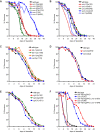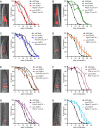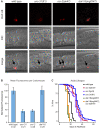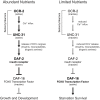A TRPV channel modulates C. elegans neurosecretion, larval starvation survival, and adult lifespan
- PMID: 18846209
- PMCID: PMC2556084
- DOI: 10.1371/journal.pgen.1000213
A TRPV channel modulates C. elegans neurosecretion, larval starvation survival, and adult lifespan
Abstract
For most organisms, food is only intermittently available; therefore, molecular mechanisms that couple sensation of nutrient availability to growth and development are critical for survival. These mechanisms, however, remain poorly defined. In the absence of nutrients, newly hatched first larval (L1) stage Caenorhabditis elegans halt development and survive in this state for several weeks. We isolated mutations in unc-31, encoding a calcium-activated regulator of neural dense-core vesicle release, which conferred enhanced starvation survival. This extended survival was reminiscent of that seen in daf-2 insulin-signaling deficient mutants and was ultimately dependent on daf-16, which encodes a FOXO transcription factor whose activity is inhibited by insulin signaling. While insulin signaling modulates metabolism, adult lifespan, and dauer formation, insulin-independent mechanisms that also regulate these processes did not promote starvation survival, indicating that regulation of starvation survival is a distinct program. Cell-specific rescue experiments identified a small subset of primary sensory neurons where unc-31 reconstitution modulated starvation survival, suggesting that these neurons mediate perception of food availability. We found that OCR-2, a transient receptor potential vanilloid (TRPV) channel that localizes to the cilia of this subset of neurons, regulates peptide-hormone secretion and L1 starvation survival. Moreover, inactivation of ocr-2 caused a significant extension in adult lifespan. These findings indicate that TRPV channels, which mediate sensation of diverse noxious, thermal, osmotic, and mechanical stimuli, couple nutrient availability to larval starvation survival and adult lifespan through modulation of neural dense-core vesicle secretion.
Conflict of interest statement
The authors have declared that no competing interests exist.
Figures







References
-
- Lindsley JE, Rutter J. Nutrient sensing and metabolic decisions. Comp Biochem Physiol B Biochem Mol Biol. 2004;139:543–559. - PubMed
-
- Colombani J, Raisin S, Pantalacci S, Radimerski T, Montagne J, et al. A nutrient sensor mechanism controls Drosophila growth. Cell. 2003;114:739–749. - PubMed
-
- Barriere A, Felix MA. High local genetic diversity and low outcrossing rate in Caenorhabditis elegans natural populations. Curr Biol. 2005;15:1176–1184. - PubMed
-
- Baugh LR, Sternberg PW. DAF-16/FOXO regulates transcription of cki-1/Cip/Kip and repression of lin-4 during C. elegans L1 arrest. Curr Biol. 2006;16:780–785. - PubMed
Publication types
MeSH terms
Substances
LinkOut - more resources
Full Text Sources
Miscellaneous

